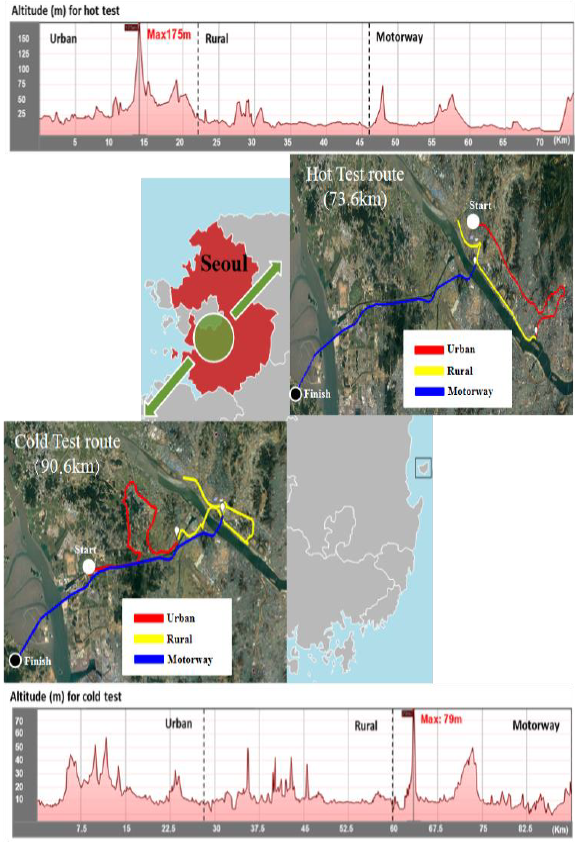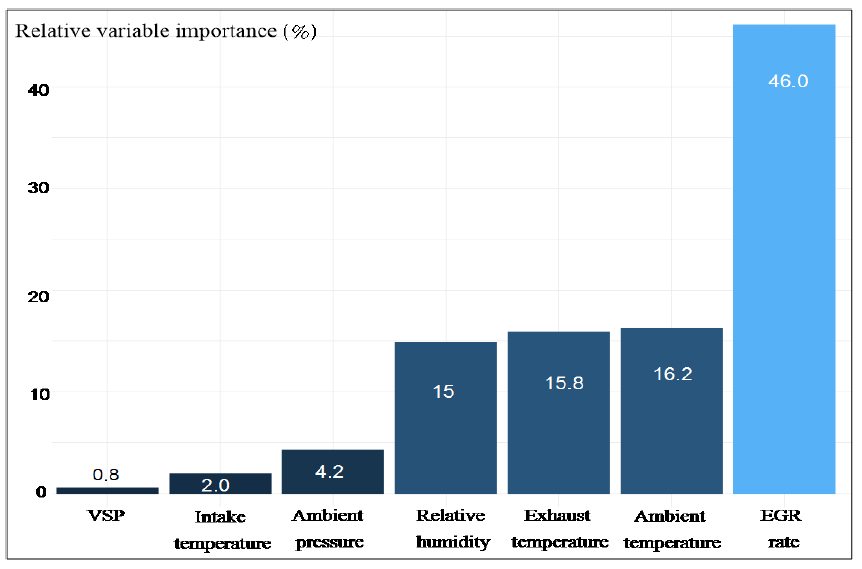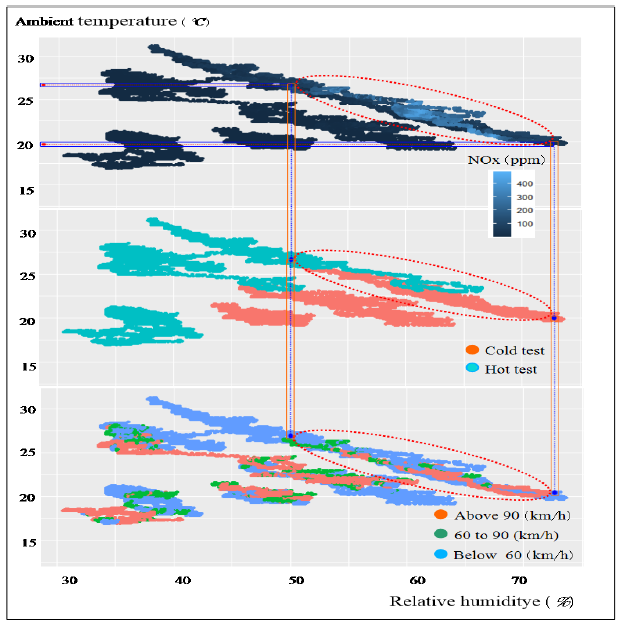Machine Learning Applied to the NOx Prediction of Diesel Vehicle under Real Driving Cycle
Abstract
1. Introduction
2. Methodology
2.1. Artificial Neural Network
2.2. Multilayer Perceptron
2.3. Backpropagation Training
3. Data Description
3.1. Selection of Test Routes
3.2. Dataset
4. ANN Model Establishment
4.1. Data Classification
4.2. Data Normalization and Training
5. Evaluation of Model Performance
6. Model Application
6.1. Analysis of Relative Variable Importance
6.2. Analysis of NOx Concentrations
7. Conclusions and Discussion
- Analysis of NOx emissions from Euro 6 diesel engines was conducted.
- Tests and analyses were performed under real-world driving conditions.
- Road environmental, atmospheric, and after-treatment factors were collected.
- The proposed ANN method predicts pollutant emissions (NOx) with good performance.
- The relative importance of each predictor on NOx emission values was derived.
Author Contributions
Funding
Institutional Review Board Statement
Informed Consent Statement
Data Availability Statement
Acknowledgments
Conflicts of Interest
References
- Valverde, V.; Giechaskiel, B. Assessment of Gaseous and Particulate Emissions of a Euro 6d-Temp Diesel Vehicle Driven >1300 km Including Six Diesel Particulate Filter Regenerations. Atmosphere 2020, 11, 645. [Google Scholar] [CrossRef]
- Anenberg, S.C.; Miller, J.; Minjares, R.; Du, L.; Henze, D.K.; Lacey, F.; Malley, C.S.; Emberson, L.; Franco, V.; Klimont, Z.; et al. Impacts and mitigation of excess diesel-related NOx emissions in 11 major vehicle markets. Nat. Cell Biol. 2017, 545, 467–471. [Google Scholar] [CrossRef] [PubMed]
- Link, M.F.; Kim, J.; Park, G.; Lee, T.; Park, T.; Bin Babar, Z.; Sung, K.; Kim, P.; Kang, S.; Kim, J.S.; et al. Elevated production of NH4NO3 from the photochemical processing of vehicle exhaust: Implications for air quality in the Seoul Metropolitan Region. Atmos. Environ. 2017, 156, 95–101. [Google Scholar] [CrossRef]
- Platt, S.M.; El Haddad, I.; Pieber, S.M.; Zardini, A.A.; Suarez-Bertoa, R.; Clairotte, M.; Daellenbach, K.R.; Huang, R.-J.; Slowik, J.G.; Hellebust, S.; et al. Gasoline cars produce more carbonaceous particulate matter than modern filter-equipped diesel cars. Sci. Rep. 2017, 7, 4926. [Google Scholar] [CrossRef]
- Transport Policy. Topics: Emissions Standards. 2017. Available online: http://www.transportpolicy.net/topic/emissions-standards (accessed on 12 March 2021).
- Winkler, S.L.; Anderson, J.E.; Garza, L.; Ruona, W.C.; Vogt, R.; Wallington, T.J. Vehicle criteria pollutant (PM, NOx, CO, HCs) emissions: How low should we go? npj Clim. Atmos. Sci. 2018, 1, 26. [Google Scholar] [CrossRef]
- Johnson, T.V. Review of Vehicular Emissions Trends. SAE Int. J. Engines 2015, 8, 1152–1167. [Google Scholar] [CrossRef]
- International Council on Clean Transportation. NOX Control Technologies for Euro 6 Diesel Passenger cars-Market Penetration and Experimental Performance Assessment. 2015. Available online: www.theicct.org (accessed on 11 March 2021).
- Baldino, C.; Tietge, U.; Muncrief, R.; Bernard, Y.; Mock, P. Road Tested: Comparative Overview of Real-World Versus Type-Approval NOx and CO2 Emissions from Diesel Cars in Europe; International Council on Clean Transportation: Washington, DC, USA, 2017. [Google Scholar]
- Degraeuwe, B.; Weiss, M. Does the New European Driving Cycle (NEDC) really fail to capture the NOX emissions of diesel cars in Europe? Environ. Pollut. 2017, 222, 234–241. [Google Scholar] [CrossRef]
- Hooftman, N.; Messagie, M.; Van Mierlo, J.; Coosemans, T. A review of the European passenger car regulations—Real driving emissions vs local air quality. Renew. Sustain. Energy Rev. 2018, 86, 1–21. [Google Scholar] [CrossRef]
- Posada, F.; Badshah, H.; Rodriguez, F. In-Use NOx Emissions and Compliance Evaluation for Modern Heavy-Duty Vehicles in Europe and the United States. International Council on Clean Transportation. 2020. Available online: https://theicct.org/publications/inuse-nox-hdvs-us-eu (accessed on 12 March 2021).
- Ministero delle Infrastrutture e dei Trasporti; Istituto Motori del CNR. Report Finale Programma di Prove per la Valutazione del Comportamento Emissivo di Vetture Diesel Euro 5 Commercializzate in Italia con Prove in Laboratorio e su Pista; Istituto Motori del CNR: Napoli, Italy, 2017. [Google Scholar]
- Parloff, R. How VW paid $25 billion for ’Dieselgate’—And got off easy. Fortune, 28 August 2018. [Google Scholar]
- European Commission. Commission regulation (EU) 2017/1151 of 1 June 2017 supplementing Regulation (EC) No 715/2007 of the European Parliament and of the Council on Type-Approval of motor Vehicles With Respect to Emissions from Light Passenger and Commercial Vehicles (Euro 5 and Euro 6) and on Access to Vehicle Repair and Maintenance Information, Amending Directive 2007/46/EC of the European Parliament and of the Council, Commission Regulation (EC) No 692/2008 and Commission Regulation (EU) No 1230/2012 and repealing Commission Regulation (EC) No 692/2008. Off. J. Eur. Union OJL 2017, 175, 1–643. [Google Scholar]
- Suarez-Bertoa, R.; Valverde, V.; Clairotte, M.; Pavlovic, J.; Giechaskiel, B.; Franco, V.; Kregar, Z.; Astorga, C. On-road emissions of passenger cars beyond the boundary conditions of the real-driving emissions test. Environ. Res. 2019, 176, 108572. [Google Scholar] [CrossRef]
- Chong, H.S.; Park, Y.; Kwon, S.; Hong, Y. Analysis of real driving gaseous emissions from light-duty diesel vehicles. Transp. Res. Part D Transp. Environ. 2018, 65, 485–499. [Google Scholar] [CrossRef]
- Costagliola, M.A.; Costabile, M.; Prati, M.V. Impact of road grade on real driving emissions from two Euro 5 diesel vehicles. Appl. Energy 2018, 231, 586–593. [Google Scholar] [CrossRef]
- Kean, A.J.; Harley, R.A.; Kendall, G.R. Effects of Vehicle Speed and Engine Load on Motor Vehicle Emissions. Environ. Sci. Technol. 2003, 37, 3739–3746. [Google Scholar] [CrossRef]
- Brundell-Freij, K.; Ericsson, E. Influence of street characteristics, driver category and car performance on urban driving patterns. Transp. Res. Part D Transp. Environ. 2005, 10, 213–229. [Google Scholar] [CrossRef]
- Ericsson, E. Independent driving pattern factors and their influence on fuel-use and exhaust emission factors. Transp. Res. Part D Transp. Environ. 2001, 6, 325–345. [Google Scholar] [CrossRef]
- Paramashivaiah, B.M.; Banapurmath, N.R.; Rajashekhar, C.R.; Khandal, S.V. Studies on Effect of Graphene Nanoparticles Addition in Different Levels with Simarouba Biodiesel and Diesel Blends on Performance, Combustion and Emission Characteristics of CI Engine. Arab. J. Sci. Eng. 2018, 43, 4793–4801. [Google Scholar] [CrossRef]
- Chaichan, M.T.; Kadhum, A.A.H.; Al-Amiery, A.A. Novel technique for enhancement of diesel fuel: Impact of aqueous alumina nano-fluid on engine’s performance and emissions. Case Stud. Therm. Eng. 2017, 10, 611–620. [Google Scholar] [CrossRef]
- Chiatti, G.; Chiavola, O.; Frezzolini, P.; Palmieri, F. On the link between diesel spray asymmetry and off-axis needle dis-placement. Appl. Sci. 2017, 7, 375. [Google Scholar] [CrossRef]
- Bermúdez, V.; Serrano, J.R.; Piqueras, P.; Sanchis, E.J. On the Impact of Particulate Matter Distribution on Pressure Drop of Wall-Flow Particulate Filters. Appl. Sci. 2017, 7, 234. [Google Scholar] [CrossRef]
- Biancofiore, F.; Busilacchio, M.; Verdecchia, M.; Tomassetti, B.; Aruffo, E.; Bianco, S.; Di Tommaso, S.; Colangeli, C.; Rosatelli, G.; Di Carlo, P. Recursive neural network model for analysis and forecast of PM10 and PM2.5. Atmos. Pollut. Res. 2017, 8, 652–659. [Google Scholar] [CrossRef]
- Russo, A.; Lind, P.G.; Raischel, F.; Trigo, R.; Mendes, M. Neural network forecast of daily pollution concentration using optimal meteorological data at synoptic and local scales. Atmos. Pollut. Res. 2015, 6, 540–549. [Google Scholar] [CrossRef]
- Fang, D.; Wang, J. A novel application of artificial neural network for wind speed estimation. Int. J. Sustain. Energy 2015, 36, 1–15. [Google Scholar] [CrossRef]
- Sofuoglu, S.C.; Sofuoglu, A.; Birgili, S.; Tayfur, G. Forecasting Ambient Air SO2 Concentrations Using Artificial Neural Networks. Energy Sources Part B Econ. Plan. Policy 2006, 1, 127–136. [Google Scholar] [CrossRef][Green Version]
- Delen, D.; Sharda, R.; Bessonov, M. Identifying significant predictors of injury severity in traffic accidents using a series of artificial neural networks. Accid. Anal. Prev. 2006, 38, 434–444. [Google Scholar] [CrossRef]
- Bawa, V.S.; Kumar, V. Linearized sigmoidal activation: A novel activation function with tractable non-linear charac-teristics to boost representation capability. Expert Syst. Appl. 2009, 120, 346–356. [Google Scholar] [CrossRef]
- Luy, M.; Saray, U. Wind speed estimation for missing wind data with three different backpropagation algorithms. Energy Educ. Sci. Technol. Part A Energy Sci. Res. 2012, 30, 45–54. [Google Scholar]
- Gonzalez, R.C.; Woods, R.E. Digital Image Processing; Addison-Wesley: New York, NY, USA, 1993. [Google Scholar]
- Kingdon, J.; Bsc, J.K.M. Intelligent Systems and Financial Forecasting; Springer: Berlin/Heidelberg, Germany, 1997. [Google Scholar]
- Bodisco, T.; Zare, A. Practicalities and Driving Dynamics of a Real Driving Emissions (RDE) Euro 6 Regulation Homologation Test. Energies 2019, 12, 2306. [Google Scholar] [CrossRef]
- Kang, G.; Lee, J.; Park, J.; Cha, J.; Chon, M.S. Development of Korean RDE Routes for On-road Emissions Measurement of Light Duty Vehicles. Trans. Korean Soc. Automot. Eng. 2017, 25, 287–296. [Google Scholar] [CrossRef]
- Ministry of Environment in South Kore. Evaluations of Real Driving Emissions (RDE-LDV) with Light-Duty Vehicles (LDVs)—Research on Introduction of 3rd RDE Package; NIER NO.11-1480523-003289-01 NIER-SP2017-215; Ministry of Environment in South Kore: Sejong City, Korea, 2017.
- Cicero-Fernândez, P.; Long, J.R.; Winer, A.M. Effects of grades and other loads on on-road emissions of hydrocarbons and carbon monoxide. J. Air Waste Manag. Assoc. 1997, 47, 898–904. [Google Scholar] [CrossRef]
- Zhou, H.; Zhao, H.; Feng, Q.; Yin, Z.; Li, J.; Qin, K.; Li, M.; Cao, L. Effects of Environmental Parameters on Real-World NOx Emissions and Fuel Consumption for Heavy-Duty Diesel Trucks Using an OBD Approach. SAE Tech. Pap. Ser. 2018. [Google Scholar] [CrossRef]
- Provataris, S.A.; Savva, N.S.; Chountalas, T.D.; Hountalas, D.T. Prediction of NOx emissions for high speed DI Diesel engines using a semi-empirical, two-zone model. Energy Convers. Manag. 2017, 153, 659–670. [Google Scholar] [CrossRef]
- EPA. Motor Vehicle Emission Simulator; EPA: Washington, DC, USA, 2010.
- Ko, M.; Lord, D.; Zietsman, J. Environmentally Conscious Highway Design for Crest Vertical Curves. Transp. Res. Rec. J. Transp. Res. Board 2012, 2270, 96–106. [Google Scholar] [CrossRef]
- Jiménez-Palacios, J.L. Understanding and Quantifying Motor Vehicle Emissions with Vehicle Specific Power and TILDAS Remote Sensing; University of Cambridge: Cambridge, UK, 1999. [Google Scholar]
- Zhai, Z.; Tu, R.; Xu, J.; Wang, A.; Hatzopoulou, M. Capturing the Variability in Instantaneous Vehicle Emissions Based on Field Test Data. Atmosphere 2020, 11, 765. [Google Scholar] [CrossRef]
- Khalid, A. Effect of Ambient Temperature and Oxygen Concentration on Ignition and Combustion Process of Diesel Spray. Asian J. Sci. Res. 2013, 6, 434–444. [Google Scholar] [CrossRef]
- McCormick, R.; Graboski, M.; Newlin, A.; Ross, J. Effect of Humidity on Heavy-Duty Transient Emissions from Diesel and Natural Gas Engines at High Altitude. J. Air Waste Manag. Assoc. 1997, 47, 784–791. [Google Scholar] [CrossRef]
- Kumar, B.R.; Saravanan, S. Effect of exhaust gas recirculation (EGR) on performance and emissions of a constant speed DI diesel engine fueled with pentanol/diesel blends. Fuel 2015, 160, 217–226. [Google Scholar] [CrossRef]
- Plee, S.; Ahmad, T.; Myers, J.; Faeth, G. Diesel NOx emissions—A simple correlation technique forintake air effects. Symp. Combust. 1982, 19, 1495–1502. [Google Scholar] [CrossRef]
- Strots, V.O.; Santhanam, S.; Adelman, B.J.; Griffin, G.A.; Derybowski, E.M. Deposit Formation in Urea-SCR Systems. SAE Int. J. Fuels Lubr. 2009, 2, 283–289. [Google Scholar] [CrossRef]
- European Commission. Including Cold-Start Emissions in the Real-Driving Emissions (RDE) Test Procedure—An Assessment of Cold-Start Frequencies and Emission Effects. JRC 105595, EUR 28472 EN. 2017. Available online: https://ec.europa.eu/jrc (accessed on 16 March 2021).
- Zhu, G.; Liu, J.; Fu, J.; Xu, Z.; Guo, Q.; Zhao, H. Experimental study on combustion and emission characteristics of turbocharged gasoline direct injection (GDI) engine under cold start new European driving cycle (NEDC). Fuel 2018, 215, 272–284. [Google Scholar] [CrossRef]
- Mahadevan, G.; Subramanian, S. Experimental Investigation of Cold Start Emission using Dynamic Catalytic Converter with Pre-Catalyst and Hot Air Injector on a Multi Cylinder Spark Ignition Engine. SAE Tech. Pap. Ser. 2017, 1. [Google Scholar] [CrossRef]
- Rath, M.K.; Acharya, S.K.; Patnaik, P.P. CI engine performance during cold weather condition using preheated air and engine by waste energy. Int. J. Ambient. Energy 2017, 38, 534–540. [Google Scholar] [CrossRef]
- European Environmental Agency. Air Quality in Europe—2016 Report; European Environmental Agency: Copenhagen, Denmark, 2016.
- Gao, J.; Tian, G.; Sorniotti, A.; Karci, A.E.; Di Palo, R. Review of thermal management of catalytic converters to decrease engine emissions during cold start and warm up. Appl. Therm. Eng. 2019, 147, 177–187. [Google Scholar] [CrossRef]
- Lahiri, S.K.; Khalfe, N. Process Modeling and Optimization Strategies Integrating Support Vector Regression and Differential Evolution: A Study of Industrial Ethylene Oxide Reactor. Chem. Prod. Process. Model. 2008, 3. [Google Scholar] [CrossRef]
- Garson, G.D. Interpreting neural network connection weights. Artif. Intell. Expert 1991, 6, 46–51. [Google Scholar]
- Goh, A. Back-propagation neural networks for modeling complex systems. Artif. Intell. Eng. 1995, 9, 143–151. [Google Scholar] [CrossRef]
- Olden, J.D.; Joy, M.K.; Death, R.G. An accurate comparison of methods for quantifying variable importance in artificial neural networks using simulated data. Ecol. Model. 2004, 178, 389–397. [Google Scholar] [CrossRef]
- Grange, S.K.; Farren, N.J.; Vaughan, A.R.; Rose, R.A.; Carslaw, D.C. Strong Temperature Dependence for Light-Duty Diesel Vehicle NOx Emissions. Environ. Sci. Technol. 2019, 53, 6587–6596. [Google Scholar] [CrossRef]








| Driving Portion | KOR-NIER Route for Cold Test | KOR-NIER Route for Hot Test | ||||||
|---|---|---|---|---|---|---|---|---|
| Urban | Rural | Motorway | Total | Urban | Rural | Motorway | Total | |
| Trip distance (km) | 32.7 | 29.0 | 28.9 | 90.6 | 26.5 | 19.7 | 27.4 | 73.6 |
| Trip share (%) | 36.1 | 32.0 | 31.9 | 100.0 | 36.0 | 26.7 | 37.3 | 100.0 |
| Trip duration (s) | 3576 | 1361 | 999 | 5936 | 4308 | 951 | 930 | 6189 |
| Average vehicle speed (km/h) | 32.9 | 76.7 | 104.1 | - | 22.1 | 74.6 | 106.1 | - |
| Vehicle Type | Fuel | Emissions Level | Emission Reduction Technology | Test Day |
|---|---|---|---|---|
| SUV | Diesel | Euro 6 | - Selective catalytic reduction - Exhaust gas recirculation - Lean NOx trap - Diesel particulate filter | Hot test: 24 September 2019 Cold test: 20 September 2019 |
| SUV | Hot test: 14 October 2019 Cold test: 10 October 2019 | |||
| Sedan | Hot test: 6 August 2018 Cold test: 6 July 2018 | |||
| - Selective catalytic reduction - Exhaust gas recirculation - Diesel particulate filter |
| Variable | Definition | Code and Value |
|---|---|---|
| Relative humidity | Numerical value: range of 30.5–73.6%, mean: 48.0% | |
| Ambient temperature | Numerical value: range of 15.8–31.3 °C, mean: 22.9 °C | |
| Ambient pressure | Numerical value: range of 989–1023 mbar, mean: 1010 mbar | |
| Vehicle specific power | Numerical value: range of −35.9–68.2 kW/ton, mean: 4.9 kW/ton | |
| Intake air temperature | Numerical value: range of 18–54 °C, mean: 29.2 °C | |
| EGR rate | Numerical value: range of 0–30.2%, mean: 14.97% | |
| Exhaust temperature | Numerical value: range of 22.2–200 °C, mean: 80.5 °C | |
| Y | NOx coefficient | Numerical value: range of 0–3779 ppm, mean: 38.5 ppm |
| Variable | Minimum | First Quartile | Median | Mean | Third Quartile | Maximum |
|---|---|---|---|---|---|---|
| 0.0000 | 0.1787 | 0.3828 | 0.4063 | 0.5940 | 1.0000 | |
| 0.0000 | 0.4585 | 0.5463 | 0.5936 | 0.7561 | 1.0000 | |
| 0.0000 | 0.4706 | 0.6471 | 0.6053 | 0.7353 | 1.0000 | |
| 0.0000 | 0.3901 | 0.4181 | 0.4433 | 0.5173 | 1.0000 | |
| 0.0000 | 0.1667 | 0.2500 | 0.3101 | 0.4167 | 1.0000 | |
| 0.0000 | 0.0000 | 0.1733 | 0.1889 | 0.2772 | 1.0000 | |
| 0.0000 | 0.2522 | 0.3122 | 0.3270 | 0.3728 | 1.0000 | |
| y | 0.0000000 | 0.0001588 | 0.0004498 | 0.0101813 | 0.0040482 | 1.0000 |
Publisher’s Note: MDPI stays neutral with regard to jurisdictional claims in published maps and institutional affiliations. |
© 2021 by the authors. Licensee MDPI, Basel, Switzerland. This article is an open access article distributed under the terms and conditions of the Creative Commons Attribution (CC BY) license (https://creativecommons.org/licenses/by/4.0/).
Share and Cite
Lee, J.; Kwon, S.; Kim, H.; Keel, J.; Yoon, T.; Lee, J. Machine Learning Applied to the NOx Prediction of Diesel Vehicle under Real Driving Cycle. Appl. Sci. 2021, 11, 3758. https://doi.org/10.3390/app11093758
Lee J, Kwon S, Kim H, Keel J, Yoon T, Lee J. Machine Learning Applied to the NOx Prediction of Diesel Vehicle under Real Driving Cycle. Applied Sciences. 2021; 11(9):3758. https://doi.org/10.3390/app11093758
Chicago/Turabian StyleLee, Jonghak, Sangil Kwon, Hyungjun Kim, Jihoon Keel, Taekwan Yoon, and Jongtae Lee. 2021. "Machine Learning Applied to the NOx Prediction of Diesel Vehicle under Real Driving Cycle" Applied Sciences 11, no. 9: 3758. https://doi.org/10.3390/app11093758
APA StyleLee, J., Kwon, S., Kim, H., Keel, J., Yoon, T., & Lee, J. (2021). Machine Learning Applied to the NOx Prediction of Diesel Vehicle under Real Driving Cycle. Applied Sciences, 11(9), 3758. https://doi.org/10.3390/app11093758






